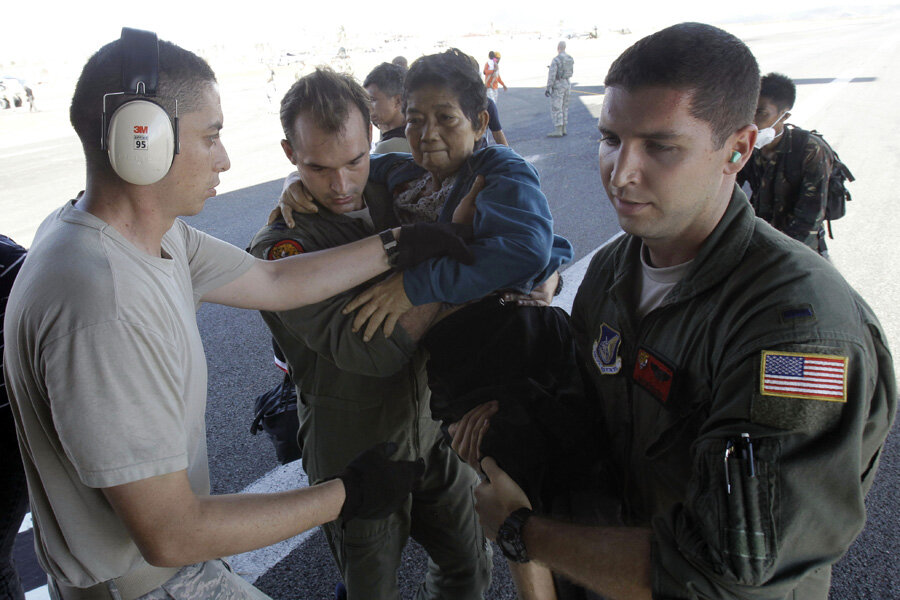US-Philippines military ties bolster typhoon relief work
Loading...
| Tacloban, Philippines
The moon is rising over the devastated coastline of Tacloban as the US military cargo plane circles the runway.
Marines take catnaps on top of 7-ft.-tall pallets of rice and other supplies, their feet dangling above the heads of aid workers who pack the jump seats, hitching rides to the hardest-hit areas. Below, bonfires dot the landscape in areas where the water has begun to recede after a 20 ft.-high storm surge.
As US military personnel continue to flow into the country, the large and growing US footprint is in full evidence. But American commanders on the ground here emphasize, repeatedly and robustly, that they take their cues from the Philippine military and national police. Indeed, military cooperation between the US and The Philippines has been fostered over years of joint US-Philippine military exercises – and those ties are being borne out now, US military officials say, as the US pulls its Pacific assets into the country to assist with relief efforts.
“They fly American-made helicopters and train with us constantly,” says Col. John Peck, chief of taff for the 3rd Marine Expeditionary Brigade. “They are extremely capable.”
'I know that guy'
Beside the runway, dozens of Tacloban residents wait in neat lines for evacuation from what the Weather Channel’s hurricane experts have dubbed “the top end of any tropical system that we’ve seen on our planet.”
There is the earliest beginning of some sign of life on the roads, where cars can now begin to try to make their way through through the coastal city as bulldozers work round the clock to clear the rubble, a top priority.
A team of US Navy amphibious ships is scheduled to arrive into the region Tuesday, bringing with them heavy engineering equipment, including more bulldozers, as well as backhoes, dump trucks, and wreckers, at the request of the Philippine government.
These vehicles will clear roads in order to allow the Philippine military to start moving in food, shelter, water, and gas “on their own,” says Rear Admiral Denny Wetherald, who commands the US Navy’s 7th Fleet. “We can move stuff, but it’s important to get the indigenous transport going.”
Exercises with the Philippine military over the course of his career has helped build these relationships between the militaries. “I was just here a month ago,” says Brig. Gen. Paul Kennedy, 3rd Marine Expeditionary Brigade commander.
And so when his brigade arrived in the wake of the typhoon, they recognized their counterparts immediately. “You look around and it’s, ‘Hey, I know that guy,’ ” General Kennedy says.
“I’ve been here for 30 years in and out,” Kennedy adds. His executive officer has spent time stationed in The Philippines, working out of the embassy. With his relationships now, he can work his considerable connections to move aid more quickly, Kennedy adds.
A former Philippine Navy SEAL, Capt. Roy Trinidad, directs the aid effort at the Tacloban airport, where the building’s typhoon-pummeled roof now resembles a grade-schooler’s hastily abandoned popsicle-stick project.
Kennedy “hijacked” one of his unit’s all-terrain vehicle for Captain Trinidad, who had a lot of ground to cover but “was spending all this time walking – it was inefficient.”
If a US military presence on the ground is rarely hailed as a plus in other parts of the world, here the population expresses gratitude on a frequent basis to US service members they see in hotel lobbies and coffees shops around Manila.
As the flight from Tacloban lands, one evacuee sitting cross-legged in the belly of the C-130 shouts “thank you!” over the roar of the taxiing engine.
He is quickly joined in a chorus of “thank you’s” as evacuees, carrying their worldly possessions in tattered school backpacks and plastic bags, file off the ramped rear of the plane.





